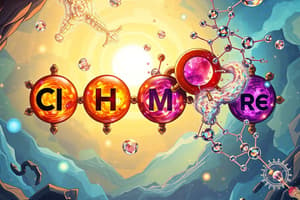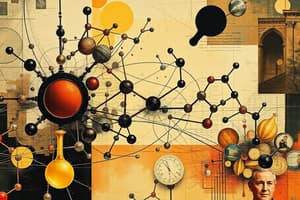Podcast
Questions and Answers
What is the oxidation state of iron in the $Fe^{2+}$ ion?
What is the oxidation state of iron in the $Fe^{2+}$ ion?
2+
What is the colour of the solution containing $MnO_4^-$ ions?
What is the colour of the solution containing $MnO_4^-$ ions?
Purple
What is the oxidation state of manganese in the $MnO_4^-$ ion?
What is the oxidation state of manganese in the $MnO_4^-$ ion?
7+
What is the colour of the solution containing $Fe^{3+}$ ions?
What is the colour of the solution containing $Fe^{3+}$ ions?
What is the product of the oxidation of $I^-$ ions in the reaction with $Fe^{3+}$ ions?
What is the product of the oxidation of $I^-$ ions in the reaction with $Fe^{3+}$ ions?
What is the purpose of the redox reaction between $Fe^{2+}$ ions and $MnO_4^-$ ions?
What is the purpose of the redox reaction between $Fe^{2+}$ ions and $MnO_4^-$ ions?
What is the oxidation state of iron in the reactant of the equation: 2Fe+(aq) + 21-(aq) → 2Fe²* (aq) + 1,(aq)?
What is the oxidation state of iron in the reactant of the equation: 2Fe+(aq) + 21-(aq) → 2Fe²* (aq) + 1,(aq)?
Using Table 1, explain why Fe²⁺ is oxidised to Fe³⁺ in the presence of MnO₄⁻ in acid conditions.
Using Table 1, explain why Fe²⁺ is oxidised to Fe³⁺ in the presence of MnO₄⁻ in acid conditions.
What happens to iodine in the reaction with Fe³⁺ ions?
What happens to iodine in the reaction with Fe³⁺ ions?
What is the role of electrode potential in predicting the direction of a redox reaction?
What is the role of electrode potential in predicting the direction of a redox reaction?
Why does the reaction between Fe²⁺ and MnO₄⁻ occur spontaneously?
Why does the reaction between Fe²⁺ and MnO₄⁻ occur spontaneously?
What is the oxidising agent in the reaction between Fe³⁺ and I⁻?
What is the oxidising agent in the reaction between Fe³⁺ and I⁻?
Flashcards are hidden until you start studying
Study Notes
Redox Reactions Involving Iron Ions
- The reaction between Fe²⁺(aq) and I⁻(aq) results in Fe²⁺ being reduced to Fe²⁺ and I⁻ being oxidised to I₂.
- The equation for this reaction is: 2Fe²⁺(aq) + 2I⁻(aq) → 2Fe²⁺(aq) + I₂(aq)
- The reaction involves a colour change, from orange-brown to pale green.
Standard Electrode Potentials
- Standard electrode potentials can be used to explain why redox reactions occur.
- A more positive E value indicates that the equilibrium is more likely to gain electrons, shifting to the right and undergoing reduction.
- Table 1 shows the standard electrode potentials for iron redox reactions.
Redox Reactions with Manganese and Iodine
- The reaction between Fe²⁺ and MnO₄⁻ in acid conditions results in Fe²⁺ being oxidised to Fe³⁺ and MnO₄⁻ being reduced to Mn²⁺.
- The E value for MnO₄⁻/Mn²⁺ is more positive than for Fe³⁺/Fe²⁺, so Fe²⁺ is oxidised to Fe³⁺ and MnO₄⁻ is reduced to Mn²⁺.
- The reaction between Fe³⁺ and I⁻ results in I⁻ being oxidised to I₂ and Fe³⁺ being reduced to Fe²⁺.
- The E value for Fe³⁺/Fe²⁺ is more positive than for I₂/I⁻, so I⁻ is oxidised to I₂ and Fe³⁺ is reduced to Fe²⁺.
Learning Outcomes
- Demonstrate knowledge and understanding of redox reactions and accompanying colour changes for the Fe²⁺/Fe³⁺ and Cr³⁺/Cr₂O₇²⁻ systems.
- Apply knowledge of redox and disproportionation reactions of copper.
- Perform qualitative analysis of ions on a test-tube scale.
Redox Titration
- The redox reaction between Fe²⁺ and MnO₄⁻ in acid conditions is used as a basis for a redox titration.
- The equation for the reaction is: MnO₄⁻(aq) + 8H⁺(aq) + 5Fe²⁺(aq) → Mn²⁺(aq) + 5Fe³⁺(aq) + 4H₂O(l)
- The solution containing MnO₄⁻ ions is purple and is decolourised by Fe²⁺(aq) ions to form a colourless solution containing Mn²⁺(aq) ions.
Studying That Suits You
Use AI to generate personalized quizzes and flashcards to suit your learning preferences.




